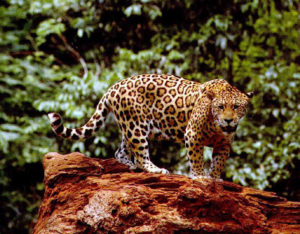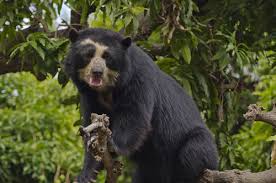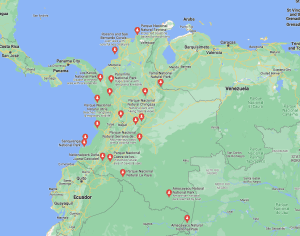Jaguars were widespread throughout South and Central America now they are becoming increasingly isolated in smaller pockets of Mexico, Belize, Guatamala, Costa Rica Panama, Peru, Colombia and Brazil. Panthera are fighting to keep the wildlife corridor open as much as possible and save as much forrest as they can.
BOGOTA BIRDING & COLOMBIA WILDLIFE TOURS


Colombia is an amazing country to visit and offers a chance of seeing
jaguars They are threatened and extremely hard to observe in the wild on account of their nocturnal habits and shyness, but they are also surprisingly widespread in Colombia – even occurring in popular tourist spots like Tayrona National Park, The best place to seek out a jaguar is La Aurora Ecolodge in the plains of Casanare, where guests can join late-night drives to inspect camera traps set up to monitor jaguar populations. El Tuparro National Park in Vichada, Munchique National Park in Caucua, The Serrania de la Macarena in Meta and the Sierra Nevada de Santa Marta.
Spectacled Bear is a rare inhabitant of high-altitude moors and forests. it’s hard to spot a spectacled bear in the wild, but the best place to do so is the vast moorlands of Chingaza National Park, just outside Bogotá. Purace National Park near Popayan, Serrania de los Churumbelos in south Colombia.
Sloths Amazon Rainforrest near the city of Leticia.
Andean Condor The majestic Andean condor is the largest flying bird in the world by combined measurement of weight and wingspan – and is the national bird of Colombia – in spite of the fact that fewer than 100 remain in the wild here. The best places to observe these magnificent birds in the wild in Colombia are the Cocora Valley, Puracé National Park near Ppayan and the Sierra Nevada de Santa Marta. You may be fortunate enough to spot one on a road trip across the mountains from Bogotá to Medellín.
Cotton-Top TamarinThese crazy-looking little monkeys are endemic to Colombia, meaning that they can only be seen in this country in the whole world. They are extremely rare, but luckily for wildlife enthusiasts, a small population was introduced to the Tayrona National Park in a successful attempt to preserve the species. With their curious nature and tuft of bright-white fur, cotton-top tamarins are a memorable part of a visit to Tayrona and are – gratifyingly – relatively easy to spot on the forest trails of the park at dawn and dusk.
Giant Anteater Found roaming the wide-open plains of Colombia’s eastern departments, these anteaters – also known locally as ant bears – can measure up to 7ft (2.13 m) in length, and weigh almost 100lbs (45kg). They feed primarily on termites and ants, using their massive claws and long, sticky tongues to eat thousands of insects every day.
Leatherback Turtles: On the beaches of Acandí and in Panama every year between February and July you’ll discover giant leatherback turtles slowly making their way up the beach to lay their eggs. The incubation period for these eggs is 2 months meaning you can see baby hatchlings clumsily make their way down the beach to the waiting ocean waters from April to September. You can almost guarantee to view the giant turtles laying eggs any night of the week from March to the 2nd week of June. And the best time to see both the adult turtles during the night and the hatchlings breaking free of their shells in the morning is during April and May. The ocean waters can be quite rough during February and March, so if you’d like to combine this experience with calm ocean swims and relaxing on the Caribbean beaches, it’s better to avoid these months. Estacion Septiembre a turtle sanctuary near Choco.
Humpback whales Colombia’s Pacific coast is one of the best places in the world to watch Humpback whales made even better by the isolation of the region and the harsh beauty of the rain-battered Chocó coastline. When to go: June-October. July to September are the best months for almost guaranteed sightings.Esenada Natural Park near Utria.
Poison Dart Frog With the largest number of amphibian species on earth, Colombia is probably the best place on earth to see wild frogs. But these aren’t just any frogs – Colombia is home to some of the most colourful and poisonous frogs on the planet. Known colloquially as poison dart frogs or arrow frogs – due to indigenous peoples once using their venom as a weapon during hunting – there are many different species unique to Colombia. The most spectacular species is the bright yellow golden poison frog:the most venomous vertebrate in the world and endemic to the Pacific coast of Colombia. Rana Terribilis Reserve in Timbiqui Cauca.
Pink River Dolphin The Amazon river dolphin is more commonly known as the pink river dolphin, on account of the vivid pink coloration that many take on as they get older and their skin endures more abrasions. With their strange long noses and rounded heads, as well as their shy nature, these dolphins are far from any Flipper clichés and are an amazingly beautiful addition to any visit to the Colombian Amazon. They can be seen throughout the Amazonia and Orinoquia regions of Colombia, making a trip to see – and swim with – pink river dolphins an essential part of any tour in the region. Leticia and Puerto Narino for river cruises.
Sharks are 500km off the coast at Malpelo Island

National Parks
The main high seasons in Colombia are during the Easter holidays, and from December to mid-January.
The lower seasons in Colombia run from August to mid-November and during the month of May.
Tayrona National Park: This national treasure and one of the most popular destinations in Colombia is closed for the first 2 weeks in February, the first 2 weeks in June, and the last 2 weeks of October until the 2nd of November.
Caño Cristales: A beautiful river located in the Serrania de la Macarena province of Meta, in the South-East of Colombia. Often called the River of 5 Colors or the Liquid Rainbow River, this location attracts tourists from across the world to view its crystal-clear waters and the amazing Macarenia clavígera water plant. Colombia is the only country in the world you can view this remarkable plant that only flourishes and produces its bright reddish-pink colors during the rainy season. During the dryer months of the year, the plant shrinks back and becomes dormant waiting for the rains to arrive again. Although visible from June to November, the best time to enjoy Caño Cristales is between the months of July to October.
El Guaviare: Located next to La Macarena, and famous for its rock paintings dating back 12,000 years, pink dolphins, rock structures, and caves, which can be enjoyed all year long. Included in this area you’ll also discover the beautiful Macarenia clavígera water plant. And just as in the neighboring department of La Macarenia, where you’ll discover Caño Cristales, it is only visible from June to November, with the best times to see these water plants being between the months of July to October.
The Amazon: During the dryer seasons, there are more areas of land to hike through and explore, and you may see more wildlife at the riverbanks looking for a drink or looking to eat those who are drinking. As a general rule, the driest season is July to September.
During the wet seasons, there are more tributaries to follow in a canoe or boat, and less land for wildlife to hide. So, although the areas for hiking are restricted, the areas for wildlife are also. Meaning if you’re a quiet walker, you may also spot wildlife. The rainy season runs roughly from mid-December to mid-May.
To try and get the best of both worlds the best time to visit is at the start and end of the rainy seasons. Of course, as mentioned previously predicting the weather in Colombia is near impossible to do. But by traveling between November and mid-December or May and June, you should hopefully experience some flooded areas and some dry areas to trek through. If traveling at the end of the rainy season, when things are starting to dry up, you shoul
